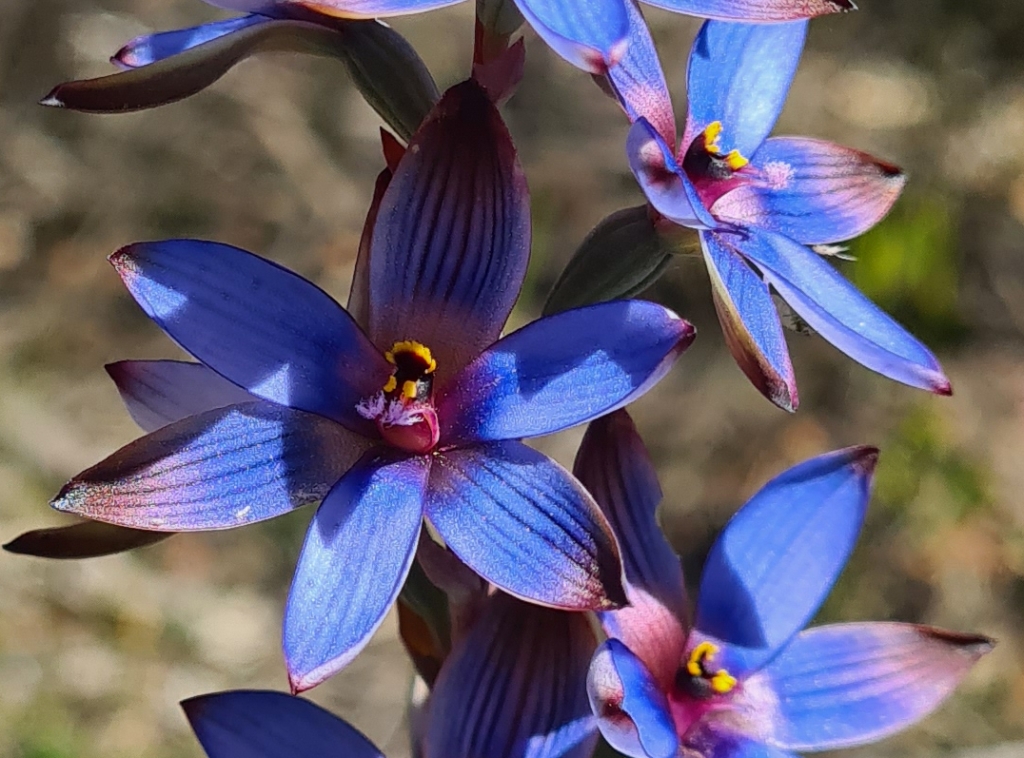Breakfast enjoyed at the Esperance Bird and Animal Park with my sister Lorraine, brother in-law Ken and Tim, Tian and kids. It was then time to show L&K the Helms Arboretum orchids. Well, the one’s flowering in late October that is.
It has been raining so the orchids are covered in drops of water which makes for some great pictures. First up we find the small but colourful Elegant donkey orchid (Diuris concinna) which flowers from September to early December between Bremer Bay and Cap Arid.

Forward projecting lateral sepals hidden under labellum 
Tapering dorsal sepal 
Up to 400mm in height 
Up to 5 flowers per orchid 
Covered in water droplets
Also, very excited to find some orchids without any colouring other than yellow. These are likely to be lutea or hypochromic versions of the Elegant donkey orchid, as the visually similar Little Esperance bee orchid is listed as a very rare orchid, so is unlikely to be found at Helms.

Tapered dorsal sepal 
Elongated petals 
Forward projecting lateral sepals hidden under labellum. 
Up to 5 flowers per orchid
Due to the damp and overcast weather the sun orchids are barely open. Firstly, the Leopard orchid (Thelymitra benthamiana) is found. These orchids flower from September to November between Northampton and Israelite Bay. Next is most likely the Scented sun orchid, however as I overlooked taking photos of the leaf, positive ID will not be possible.

Leopard patterning visible 
?? sun orchid (Thelymitra sp.) 
?? sun orchid (Thelymitra sp.) 
Multiple flowers
Other random orchids found include the Purple enamel orchid (Elythranthera brunonis) which flowers August to early November between Kalbarri and Israelite Bay; the Rattle beaks (Lyperanthus serratus) which flower September to November between Perth and Israelite Bay; and the White fairy orchid (Caladenia marginata) which flowers late September to November between Juien Bay and you guessed it, Israelite Bay.

Purple enamel orchid (Elythranthera brunonis) 
Rattle beaks (Lyperanthus serratus) 
White fairy orchid (Caladenia marginata)
Then last but definitely not least, we locate some spider orchids. The Esperance white spider orchid (Caladenia longicauda subsp. crassa) is still found in fairly good numbers, given they are recorded as flowering August to early October. The other orchid is the Esperance king spider orchid (Caladenia decora) which flowers mid-August to October. Both orchids are recorded as occurring from Bremer Bay to as far east as Israelite Bay and Cape Arid respectively.

Esperance white spider orchid (Caladenia longicauda subsp. crassa) 
Esperance white spider orchid (Caladenia longicauda subsp. crassa) 
Esperance white spider orchid (Caladenia longicauda subsp. crassa) 
Esperance king spider orchid (Caladenia decora) 
Esperance king spider orchid (Caladenia decora)
With at least eight species located it turned out to be quite a successful hunt. Oh, I would love for the yellow orchids to be the Little Esperance bee orchid, however I would require a better person than myself to name them that. However even if they are just a single-coloured variety of D. concinna, that will still be fine. Tomorrow, we head north.









































































































































































































































































